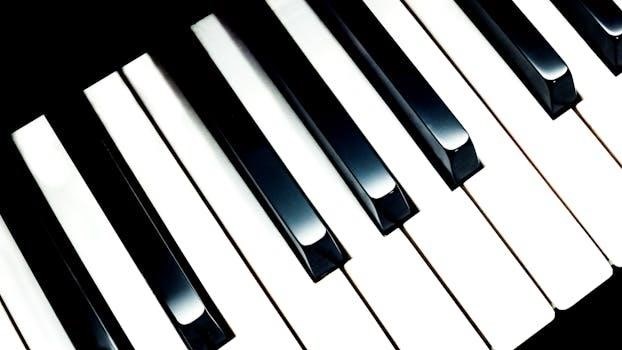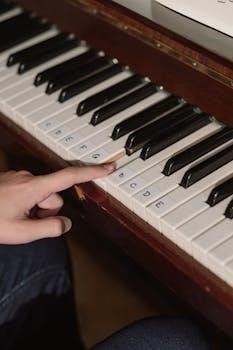Piano Keyboard Chord Chart PDF⁚ A Comprehensive Guide
Embark on a musical journey with our comprehensive guide to piano chords! This resource serves as your gateway to understanding and mastering piano chords. Whether you’re a beginner or an experienced player, a chord chart is invaluable.
Understanding Piano Chords
At its core, understanding piano chords involves recognizing that a chord is simply a group of notes played simultaneously, creating a harmonious sound. Most commonly, these consist of three notes, forming what’s known as a triad. These triads are the building blocks of countless songs and musical pieces.
The most fundamental chords you’ll encounter are major and minor chords. These two types of chords form the foundation of Western music theory and are essential for any aspiring pianist to learn.
Beyond major and minor, there are diminished and augmented chords, which add color and complexity to your playing. Understanding their structure and usage opens up a world of expressive possibilities.
Furthermore, 7th chords, with their added fourth note, create richer harmonies and a more sophisticated sound. Exploring 7th chord variations will greatly expand your musical vocabulary. Learning how these different types of chords are constructed will enhance your understanding of music theory.
By delving into the construction and characteristics of these different chord types, you’ll gain a solid foundation for playing a wide range of musical styles and composing your own original pieces.
Major and Minor Chords Explained
Major and minor chords are the cornerstones of harmony. A major chord generally conveys a bright, happy, or uplifting feeling, while a minor chord often evokes a sense of sadness, melancholy, or introspection. These contrasting emotions make them essential tools for musical expression.
The construction of major and minor chords differs by only one note, but that difference creates a world of emotional impact. A major chord consists of the root note, a major third above the root, and a perfect fifth above the root. For example, a C major chord comprises the notes C, E, and G.
In contrast, a minor chord is formed by the root note, a minor third above the root, and a perfect fifth above the root. Using C as an example again, a C minor chord includes the notes C, Eb (E flat), and G. Notice that the only difference is the E, which is lowered by a half step to become Eb.
Mastering major and minor chords is essential for any pianist. They are the building blocks of countless songs and provide a foundation for understanding more complex harmonies. Practice playing them in different keys and inversions to develop a strong understanding of their sound and function.
Diminished and Augmented Chords
Beyond major and minor chords lie the intriguing realms of diminished and augmented chords. These chords, while less frequently used than their major and minor counterparts, add distinctive colors and tensions to music. They serve as powerful tools for creating specific moods and effects.
A diminished chord is built with a root, a minor third, and a diminished fifth. This unique combination creates a dissonant and unstable sound, often used to build tension or create a sense of unease. For example, a C diminished chord consists of the notes C, Eb, and Gb. The Gb, a half-step lower than the G in a C minor chord, gives it its characteristic sound.
Conversely, an augmented chord features a root, a major third, and an augmented fifth. This combination creates a bright, yet unstable sound that can add a touch of dreaminess or surrealism. A C augmented chord, for instance, is made up of the notes C, E, and G#. The G#, raised a half-step from the G in a C major chord, gives it its expanded and slightly unsettling quality.

Diminished and augmented chords are often used as passing chords or to create dramatic effects. Understanding their construction and sound is crucial for any musician seeking to expand their harmonic palette and add depth to their compositions.
7th Chords and Their Variations
Expanding beyond triads, 7th chords introduce a fourth note, adding layers of complexity and color to your piano playing. The most common 7th chord is the dominant 7th, built by adding a minor 7th interval to a major triad. For example, a G7 chord consists of G, B, D, and F. This chord creates a strong pull towards the tonic, making it a staple in blues, jazz, and many other genres.
Another important 7th chord is the major 7th, constructed by adding a major 7th interval to a major triad. A Cmaj7, for example, includes C, E, G, and B. Major 7th chords provide a smoother, more sophisticated sound than dominant 7ths, often used in ballads and contemporary music.
Minor 7th chords are created by adding a minor 7th interval to a minor triad, resulting in chords like Am7 (A, C, E, G). These chords offer a melancholic and introspective vibe, common in jazz and R&B. Furthermore, you can find variations like minor major 7th chords, half-diminished 7th chords, and diminished 7th chords, each offering its unique sonic texture. Mastering 7th chords and their variations unlocks a world of harmonic possibilities, allowing for richer and more expressive piano playing.
Piano Chord Chart PDF⁚ A Visual Aid
A piano chord chart PDF serves as an indispensable visual aid for musicians of all levels, offering a readily accessible reference for chord fingerings and structures. These charts typically display a keyboard diagram with each chord clearly marked, indicating which keys to press to form the desired chord. The visual representation simplifies the learning process, especially for beginners who might find music theory concepts daunting.
The convenience of a PDF format allows for easy access on various devices, whether it’s a computer, tablet, or smartphone. This portability ensures that musicians can consult the chord chart during practice sessions, rehearsals, or even live performances. A well-designed chord chart PDF often includes a comprehensive collection of chords, encompassing major, minor, diminished, augmented, and 7th chords, providing a complete harmonic toolkit.
Furthermore, some advanced chord charts may incorporate inversions, slash chords, and other chord variations, expanding the musician’s knowledge and creative possibilities. The visual clarity and accessibility of a piano chord chart PDF make it an invaluable resource for both learning and performance, empowering musicians to navigate the world of chords with confidence and ease.
Free Downloadable Chord Charts
The internet is a treasure trove of free resources, and piano chord charts are no exception. Many websites offer downloadable PDF chord charts, providing an accessible and cost-effective way to learn and practice piano chords. These free charts often cover a wide range of chords, including major, minor, seventh, and other essential variations, catering to diverse musical styles and skill levels.

Downloading a free chord chart allows you to have a readily available reference guide, whether you’re practicing at home, attending lessons, or jamming with friends. The PDF format ensures compatibility across various devices, from computers and tablets to smartphones, making it convenient to access the chart whenever and wherever you need it.
When selecting a free downloadable chord chart, consider factors such as clarity, comprehensiveness, and visual appeal. A well-designed chart should be easy to read, organized logically, and include all the chords you need for your musical endeavors. While free charts may not offer the same level of customization or detail as paid resources, they provide an excellent starting point for learning piano chords and can significantly enhance your musical journey. Remember to explore different websites and compare charts to find the one that best suits your needs and preferences.
Customizable Chord Charts
For musicians seeking a more personalized learning experience, customizable chord charts offer a powerful solution. Unlike static PDF charts, customizable options allow you to tailor the chart to your specific needs and preferences. Several online tools and software programs enable you to create chord charts with the exact chords, voicings, and notations you require.
Customizable chord charts offer a unique way to learn music theory and apply it to your playing. You can experiment with different chord variations, inversions, and voicings, and then visualize them on the keyboard layout. This hands-on approach fosters a deeper understanding of chord construction and empowers you to create your own unique sounds.
The ability to customize a chord chart extends beyond simply selecting chords. Many tools allow you to adjust the layout, font size, color scheme, and other visual elements to create a chart that is both informative and aesthetically pleasing. You can also add annotations, such as fingerings, Roman numeral analysis, or song-specific instructions. The level of customization is limited only by your imagination and the capabilities of the tool you choose.
Whether you’re a songwriter, arranger, or simply a curious musician, customizable chord charts are an invaluable resource for exploring the world of piano chords.
How to Read a Piano Chord Chart

Piano chord charts are visual representations of chords, making them accessible even to beginners. Understanding how to read them unlocks a world of musical possibilities. Most charts display a keyboard diagram, indicating which keys to press for a specific chord. Each key is marked, often with a dot or number, corresponding to a finger.
Chord names, like C major or Am (A minor), are clearly labeled above the diagram. These names denote the root note and chord quality. The root is the fundamental note, while the quality (major, minor, diminished, augmented, 7th, etc.) describes the chord’s overall sound.
Some charts include fingerings, suggesting which fingers to use for each key. While these are helpful, feel free to adapt them to your hand size and playing style; Experiment to find what’s most comfortable and efficient.
Pay attention to the keyboard diagram’s orientation. Usually, the lower notes are on the left and higher notes on the right, mirroring the piano. Reading a chord chart involves identifying the chord name, locating the corresponding keys on the diagram, and pressing those keys on your piano. With practice, reading chord charts becomes second nature, allowing you to quickly learn and play a vast repertoire of chords.
Using Chord Charts for Songwriting and Practice
Piano chord charts are invaluable tools for both songwriting and practice. For songwriters, they provide a quick and easy way to experiment with different chord progressions. By referencing a chart, you can explore various chord combinations and discover harmonies that evoke specific emotions or moods. Chord charts allow you to quickly prototype song ideas without needing extensive music theory knowledge.

During practice, chord charts offer a structured approach to learning new chords and improving your playing skills. Begin by mastering basic major and minor chords, gradually progressing to more complex diminished, augmented, and 7th chords. Use the charts to visualize the finger positions and practice transitioning smoothly between chords. Regular practice with chord charts enhances your finger dexterity, muscle memory, and overall piano proficiency.
Furthermore, chord charts can aid in transposing songs to different keys. By understanding the relationships between chords, you can easily adapt a song to suit your vocal range or instrument. Whether you’re composing original music or honing your performance skills, chord charts are essential resources for any pianist.
